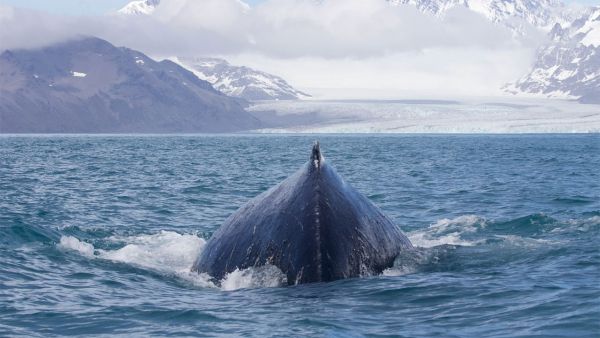Evidence Giant Blue Whale Making Comeback
In the first multi-year
survey at South Georgia Island in the southwest Atlantic
where hunting drove whales almost to extinction, an
international team of scientists reports some whale
populations may be close to full recovery while others show
promising signs of a comeback.
The
critically endangered blue whale is increasingly looking
like one of conservation’s biggest success stories and the
good news just keeps on
coming.
University of
Auckland whale researcher Dr Emma Carroll, who has co-led
the survey with Dr Jen Jackson from the British Antarctic
Survey (BAS), says the latest data from South Georgia shows
protection of whales has worked.
“South Georgia
has a similar latitude to New Zealand’s own sub-Antarctic
islands and as with our own populations of southern right
whale near the sub-Antarctic Auckland Islands, we knew
populations were increasing but these latest results are
fantastic,” she says.
“It’s also
particularly significant because whales were slaughtered in
their tens of thousands at South Georgia and to see them
return in such numbers is just an absolute
thrill.”
Surveying humpback, blue and southern
right whales, leading scientists from around the world
report humpbacks are now a common sight in coastal waters at
South Georgia with 790 reported during 21 days of surveying
this season.
A preliminary estimate suggests more
than 20,000 humpbacks are now feeding there in the summer
months before migrating to colder waters in the
sub-Antarctic to breed.
The rare and critically
endangered blue whale, the largest animal that has ever
lived, was sighted just once during the first year of the
survey, in 2018. This year blue whales were sighted or
acoustically recorded 55 times.
“Continued
protection and monitoring is required to see if this
unprecedented number of blue whales sightings is a long-term
trend, as we see in humpbacks,” Dr Jackson
says.
The southern right whale was not seen in
2019 although it was regularly sighted in 2018 and 2020. Dr
Jackson says that may be because they preferred to feed
elsewhere in 2019 but scientists will further analyse the
data to better understand feeding
behaviour.
Genetic monitoring work pioneered in
New Zealand’s southern right whales, Tohorā, will also be
used to understand how southern right whales feeding around
South Georgia are connected to wintering grounds around
South America.
“What is clear is that protection
from whaling has worked with densities of humpbacks in
particular similar to those of a century ago and we are
thrilled to see them at South Georgia again,” Dr Jackson
says.
Full list of science organisations and
key collaborators on the survey:
Sea Mammal Research
Institute at St Andrews University; the University of
Washington; the Woods Hole Oceanographic Institution;
Instituto Aqualie, Projecto Baleia Franca; University of St
Andrews; Wildscope; Oregon State University; US NOAA; the
University of Rio Grande do Norte; the Australian Antarctic
Division; Scottish Association of Marine Sciences;
University of Barcelona. Key collaborators include the
University of Auckland (conducting the genetic work),
Instituto Aqualie (collaborating on whale tracking), Woods
Hole Oceanographic Institute (studying whale health), the
Sea Mammal Research Unit (acoustic analysis and health), the
University of Barcelona (analysing the historical catch
record), Wildscope (analysing whale abundance) and Happywhale, a citizen
science based initiative who publish and share
photo-identifications of whales
online


 KiwiRail: Aratere To Retire In August
KiwiRail: Aratere To Retire In August GE Free NZ: Chief Science Advisor Needs Courage To Take Honest Look At GE Failures
GE Free NZ: Chief Science Advisor Needs Courage To Take Honest Look At GE Failures IAG New Zealand: New Zealand’s $64 Billion Spend On Natural Hazards Heavily Skewed To Recovery Over Resilience
IAG New Zealand: New Zealand’s $64 Billion Spend On Natural Hazards Heavily Skewed To Recovery Over Resilience Rail And Maritime Transport Union: Rail Workers Celebrate Hillside Workshops Rebirth
Rail And Maritime Transport Union: Rail Workers Celebrate Hillside Workshops Rebirth NZX: NZX Welcomes Changes To Prospective Financial Information
NZX: NZX Welcomes Changes To Prospective Financial Information Commerce Commission: Possible Cartel Conduct Sparks Compliance Advice
Commerce Commission: Possible Cartel Conduct Sparks Compliance Advice